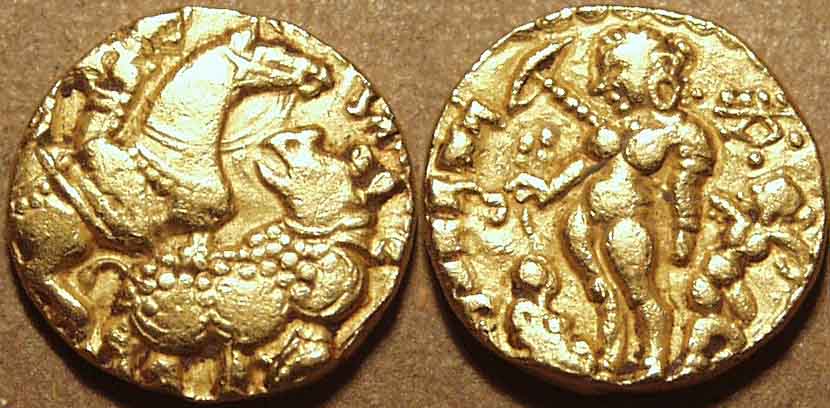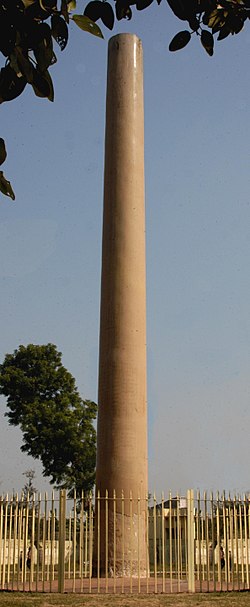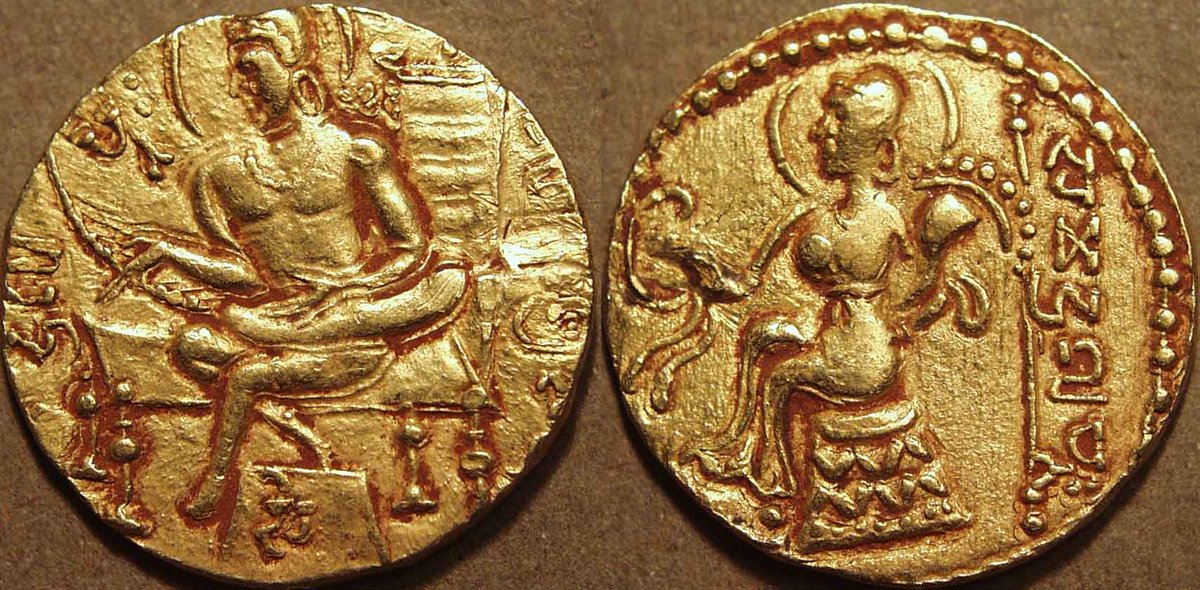
Maurya-Seleucid War (305 /303 BCE)
The war was a culmination of at least two decades of Greek efforts to subjugate NW parts of India.
The war was fought between two of the greatest empires of the ancient times... The Seleucid Empire and The Mauryan Empire.

The war was a culmination of at least two decades of Greek efforts to subjugate NW parts of India.
The war was fought between two of the greatest empires of the ancient times... The Seleucid Empire and The Mauryan Empire.
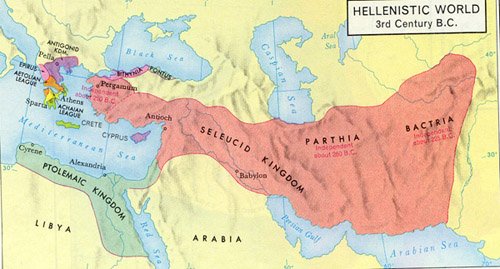

Prelude:
It must be known that Alexander of Macedon, during his conquest of the known world between 334-325 AD, subjugated whole of NW India, from Khyber to lower Indus, during a period of 19 months, between 327-325 BCE.

It must be known that Alexander of Macedon, during his conquest of the known world between 334-325 AD, subjugated whole of NW India, from Khyber to lower Indus, during a period of 19 months, between 327-325 BCE.


However, Alexander returned to Babylon as he faced mutiny at the Beas river, which was the eastern most limit of his empire.
After his death, without issue on 10 June, 323 BCE, his generals called ' Diadochi' ( succesors), divided this huge empire, from Macedonia to Indus.
After his death, without issue on 10 June, 323 BCE, his generals called ' Diadochi' ( succesors), divided this huge empire, from Macedonia to Indus.
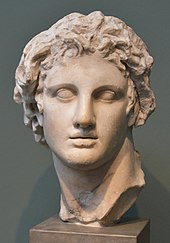
These Diadochi included generals of Alexander named, Lysimachus Ptolemy, Antogonos Monopthalamus ( the one eyed), Cassander, Seleucos Nikator, etc 

By 312 BCE, Seleukos Nikator had gained a foothold in Babylon and extended his area over whole of modern day Iran, Iraq, Syria, Baluchistan
Meanwhile, in India, and after the death of Alexander, a great war of Independence was going on.
The nationalistic fervor of Indians in those times, refused to accept defeat, even after being defeated and slaughtered by the Macedonian troops.
The nationalistic fervor of Indians in those times, refused to accept defeat, even after being defeated and slaughtered by the Macedonian troops.
What was then happening may be gathered from a historian called Justin ( Book 15, chpt 4). :
"India, after the death of Alexander, had shaken, as it were, the yoke of servitude from its neck & put his governors to death,
"India, after the death of Alexander, had shaken, as it were, the yoke of servitude from its neck & put his governors to death,
The author of this liberation was Sandrocottus ( Chandragupta). This man was of humble origin but was stimulated to aspire to regal power by supernatural encouragement,
for having offended Alexander by his boldness of speech,& orders being given to kill him, he saved himself by swiftness of his foot & while he was lying asleep, after his fatigue,a lion of great size licked off his sweat & after gently waking him, left."
Justin informs that after this, Sandrocottos drew a band of soldiers from bandits, and professional soldiers, & threw the Greeks out from the country and afterwards 'gained the throne of the country' by defeating the Nandas.
The Moves:
Meanwhile, in the West, it would appear that during the wars of Diadochi, Seleukos won for himself a secure position as the ruler of Babylon by about 312 BCE.
He felt free now, to devote himself to the consolidation of his authority in distant provinces.
Meanwhile, in the West, it would appear that during the wars of Diadochi, Seleukos won for himself a secure position as the ruler of Babylon by about 312 BCE.
He felt free now, to devote himself to the consolidation of his authority in distant provinces.
After the subjugation of Bactria ( Afg-Tajik area) not without hard fighting, he planned for the recovery of Indian provinces.
Taking the route along the Kabul river, he crossed the Indus.
The stage was set for a titanic clash between two great personalities of antiquity!

Taking the route along the Kabul river, he crossed the Indus.
The stage was set for a titanic clash between two great personalities of antiquity!


Alas, we do not know as to how the war went.
The Indians in those times did not write the accounts of the campaign, and the latter Greek and Roman writers, perhaps were too ashamed to admit that the succesor of Alexander was defeated by a "barbarian".
The Indians in those times did not write the accounts of the campaign, and the latter Greek and Roman writers, perhaps were too ashamed to admit that the succesor of Alexander was defeated by a "barbarian".
Plutarch says:
"Androcottos, who had that time mounted the throne, presented Seleukos with 500 elephants & overran & subdued whole of India with an army of 600,000."
The throne here is the throne of Magadha. The present to Seleukos was the result of war between the two.
"Androcottos, who had that time mounted the throne, presented Seleukos with 500 elephants & overran & subdued whole of India with an army of 600,000."
The throne here is the throne of Magadha. The present to Seleukos was the result of war between the two.
Thus, Seleukos Nikator's efforts to copy Alexander's campaign, ended in a humilatimg defeat.
It was because he had to confront a new India.
Strong and united under Chandragupta in command of a formidable army, & may have felt that discretion was the better part of valour.
It was because he had to confront a new India.
Strong and united under Chandragupta in command of a formidable army, & may have felt that discretion was the better part of valour.
By the terms of the treaty, Seleukos ceded to Chandragupta the satrapies of:
Archosia ( Kandahar), Paropanisadae (Kabul),
Aria ( Herat) &
Gedrosia ( Baluchistan)
in return for these four provinces, Chandragupta gave a gift of 500 elephants to Seleukos.
Archosia ( Kandahar), Paropanisadae (Kabul),
Aria ( Herat) &
Gedrosia ( Baluchistan)
in return for these four provinces, Chandragupta gave a gift of 500 elephants to Seleukos.

Thus, CG Maurya became master of an empire stretching from parts of eastern Iran and Baluchistan to Bengal, and from Kashmir to Southern Karnataka, minus Kalinga.
In addition, in one single stroke, he conquered the whole of modern day Pakistan!
In addition, in one single stroke, he conquered the whole of modern day Pakistan!

The present of elephants was followed by other expressions of friendly relations between the two kings.
It is suggested by Roman historian, Appian, that there was marriage alliance between the two kings, so that Seleukos either became the father or son-in-law of Chandragupta .
It is suggested by Roman historian, Appian, that there was marriage alliance between the two kings, so that Seleukos either became the father or son-in-law of Chandragupta .

Appian uses the word "Jus Conubii' = intermarriage, to describe the relations between Seleukos and Chandragupta.
The result of the war would indicate the defeated would submit to any demands made by the victor, & hence it is quiet logical to assume that CG Maurya married a daughter of Seleukos, to guarantee peace between the two powers.
However, no daughter named 'Helena'- as it is assumed, occurs in the list of children of Seleukos.
Secondly, India - then believed in ' Varna System', where mixing of castes were not allowed.
Thirdly, would this 'Jus Conubii' allowed in a ' land of castes', as India was ?
Secondly, India - then believed in ' Varna System', where mixing of castes were not allowed.
Thirdly, would this 'Jus Conubii' allowed in a ' land of castes', as India was ?
And fourthly, the name ' Helena' is a modern day creation, perhaps no more than 200 years old.
Additionally, the Jain texts name a woman named 'Durdhara' who was the wife of Chandragupta & mother of Bindusara.
And dispelling all fabricated stories, no son of Chandragupta named ' Justin' borne out of him & ' Helena' ever existed, as mentioned in some fabricated tv shows!
And dispelling all fabricated stories, no son of Chandragupta named ' Justin' borne out of him & ' Helena' ever existed, as mentioned in some fabricated tv shows!
That Chandragupta's relations with Seleukos remained on friendly terms, is indicated by a story by Athenaus that he sent Seleukos, a present of some Indian drugs.
Seleukos further cemented this alliance by sending Megasthenes as an ambassador to the Mauryan court.
Seleukos further cemented this alliance by sending Megasthenes as an ambassador to the Mauryan court.

Chandragupta, afterwards abdicated the throne in 298 BCE, & became a Jain monk, as per traditions.
He ended his life by way of ' Sallekhna' - voulantry fasting to death.
Seleukos was murdered in year 279 BCE.
He ended his life by way of ' Sallekhna' - voulantry fasting to death.
Seleukos was murdered in year 279 BCE.
The Greeks and Indians, afterwards, were on very friendly terms, Ashoka sent his ambassadors to the Greek world and there were lots of cultural and economic interactions between the two regions.
End.
End.

@threadreaderapp, compile
• • •
Missing some Tweet in this thread? You can try to
force a refresh



